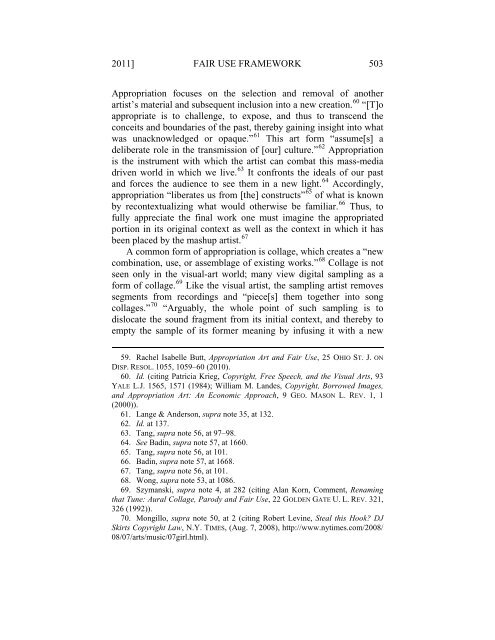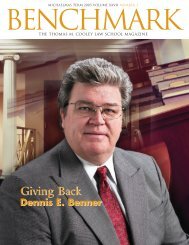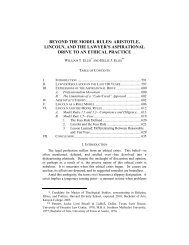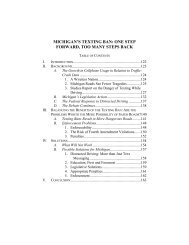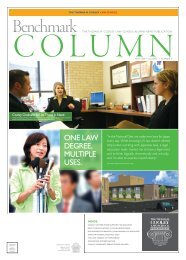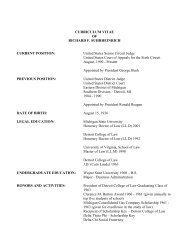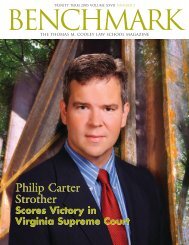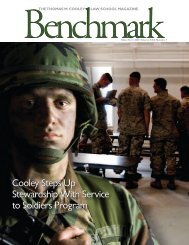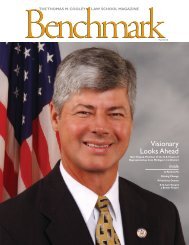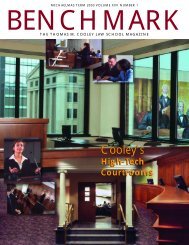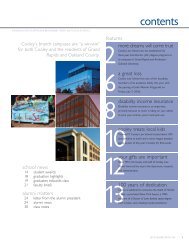Blanch It, Mix It, Mash It - Thomas M. Cooley Law School
Blanch It, Mix It, Mash It - Thomas M. Cooley Law School
Blanch It, Mix It, Mash It - Thomas M. Cooley Law School
You also want an ePaper? Increase the reach of your titles
YUMPU automatically turns print PDFs into web optimized ePapers that Google loves.
2011] FAIR USE FRAMEWORK 503<br />
Appropriation focuses on the selection and removal of another<br />
artist’s material and subsequent inclusion into a new creation. 60 “[T]o<br />
appropriate is to challenge, to expose, and thus to transcend the<br />
conceits and boundaries of the past, thereby gaining insight into what<br />
was unacknowledged or opaque.” 61 This art form “assume[s] a<br />
deliberate role in the transmission of [our] culture.” 62 Appropriation<br />
is the instrument with which the artist can combat this mass-media<br />
driven world in which we live. 63 <strong>It</strong> confronts the ideals of our past<br />
and forces the audience to see them in a new light. 64 Accordingly,<br />
appropriation “liberates us from [the] constructs” 65 of what is known<br />
by recontextualizing what would otherwise be familiar. 66 Thus, to<br />
fully appreciate the final work one must imagine the appropriated<br />
portion in its original context as well as the context in which it has<br />
been placed by the mashup artist. 67<br />
A common form of appropriation is collage, which creates a “new<br />
combination, use, or assemblage of existing works.” 68 Collage is not<br />
seen only in the visual-art world; many view digital sampling as a<br />
form of collage. 69 Like the visual artist, the sampling artist removes<br />
segments from recordings and “piece[s] them together into song<br />
collages.” 70 “Arguably, the whole point of such sampling is to<br />
dislocate the sound fragment from its initial context, and thereby to<br />
empty the sample of its former meaning by infusing it with a new<br />
59. Rachel Isabelle Butt, Appropriation Art and Fair Use, 25 OHIO ST. J. ON<br />
DISP. RESOL. 1055, 1059–60 (2010).<br />
60. Id. (citing Patricia Krieg, Copyright, Free Speech, and the Visual Arts, 93<br />
YALE L.J. 1565, 1571 (1984); William M. Landes, Copyright, Borrowed Images,<br />
and Appropriation Art: An Economic Approach, 9 GEO. MASON L. REV. 1, 1<br />
(2000)).<br />
61. Lange & Anderson, supra note 35, at 132.<br />
62. Id. at 137.<br />
63. Tang, supra note 56, at 97–98.<br />
64. See Badin, supra note 57, at 1660.<br />
65. Tang, supra note 56, at 101.<br />
66. Badin, supra note 57, at 1668.<br />
67. Tang, supra note 56, at 101.<br />
68. Wong, supra note 53, at 1086.<br />
69. Szymanski, supra note 4, at 282 (citing Alan Korn, Comment, Renaming<br />
that Tune: Aural Collage, Parody and Fair Use, 22 GOLDEN GATE U. L. REV. 321,<br />
326 (1992)).<br />
70. Mongillo, supra note 50, at 2 (citing Robert Levine, Steal this Hook? DJ<br />
Skirts Copyright <strong>Law</strong>, N.Y. TIMES, (Aug. 7, 2008), http://www.nytimes.com/2008/<br />
08/07/arts/music/07girl.html).


